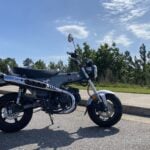The Bike Built For War, That Never Reached The Battlefield
The first time I ever laid eyes on a Harley-Davidson XA was at my friend John Landstrom’s establishment, Blue Moon Cycle, about 7-8 years ago. John has a vast array of historic North American and European motorcycles in his collection/museum, and when I came across the XA in his World War II display, I wasn’t quite sure what I was looking at. Is it a Harley? Or a BMW? Maybe a Ural knockoff of a BMW, in Allied livery? I was so confused. John proceeded to share with me a bit of the history of the XA model, and I was intrigued, being a history buff. This was a piece of Harley history I was unaware of. I later encountered one at the Harley-Davidson Museum in Milwaukee, and knew one day we’d have to tell its story.
During the Second World War, fast, light, maneuverable and mobile armor became a must on the battlefield. Germany’s “Blitzkrieg” method of warfare forever changed combat strategy, tactics, and weapons, with all forces and both sides of the conflict looking for effective solutions. Germany’s BMW R71 and R75 motorcycles and sidecar rigs proved affordable, highly efficient and easy to maintain in the harsh conditions of the often rapidly shifting frontlines, and Russia even copied these with their own IMZ-Ural M-72.
Harley-Davidson had been supplying the U.S. Army with their famous WLA model, running its traditional 45-degree V-twin mill, but in light of the durability of the BMW R71 and Soviet forces’ IMZ M72, top brass asked Harley for a new model, one with a shaft drive. The Motor Company set to work on a design based on Germany’s competent Beemer, and the XA (Experimental Army) was born. Sporting that distinctive flat twin boxer engine in side-valve and overhead-valve variations, and running on a sealed shaft drive rather than chain or belt, the XA looked to be the new 2-wheeled standard bearer for the U.S. military.
Alas, it was not to be. By the time the XA came to production, the U.S. Army had discovered and decided on the Jeep as their general-purpose, do-everything small vehicle of choice for their troops. The Jeep, of course, became the stuff of legend, and the XA disappeared into history. Only about 1016 XAs ever rolled off Harley’s assembly lines, none of which ever made it to the frontlines, neither in North Africa, the Pacific nor European theaters.
The design was actually quite reliable, with its solid shaft drive and that horizontally-opposed twin. According to the American Motorcyclist Association’s Motorcycle Hall of Fame, which also has one on display, “Mechanically, the large cooling fins stuck straight out in the breeze, reportedly keeping the XA’s oil temperature 100 degrees F (38 C) cooler than a standard Harley 45.” When the contract with the Army fell through, the engine configuration was sent by H-D to Detroit Wax Paper for testing as a possible generator set, to Willy’s-Overland (ironically) as a possible small tank motor in 1943, and to Servi-Car for a post-war prototype “Model K’ in 1946. None of these ever saw production, however.
The bike featured here is on display at the Throttlestop Museum in Elkhart Lake, Wisconsin, not far from the famed Road America racetrack. If you ever head up for any race events, be sure to stop in and check out their XA, as well as all the incredible bikes and automobiles in their collection. And with the 120th Annivserary of The Motor Company coming up this summer, be sure to tour the H-D Museum and see their XAs among the fantastic array of American iron under one roof.
Rob
*All photos courtesy The Throttlestop Museum
































Rob, Thanks for the mention of my shop. I have several military bikes for sale now, including a couple of WLAs. John Landstrom
Hi John, I was wondering if you have any XA parts for sale. Thanks in advance, Bob Green email farmguy2.rcg@gmail.com